Alpacas are unique creatures that have only been in the United States since 1984. Most people know little about them and have a difficult time locating quality facts and information. The internet is full of incorrect statements, facts, and figures. The more I read, the more incorrect information I find, and the more frustrated I become.
In this post, I'd like to answer the most common questions we receive and provide some other alpaca facts you might want to know. The data points include everything from history and population to personality traits and tips on raising alpacas.
History & Population Facts & FAQs
When were alpacas discovered?
Alpacas are one of six animals that are part of the camel family, known as Camelidae. The ancestors of today’s camelids evolved in North America between 9-11 million years ago, although it is said that the most distant relatives were living as far back as 35 million years ago.
When were alpacas domesticated?
Alpacas were domesticated over 6,000 years ago. The domestic form of the alpaca is Vicugna paco.
How many alpacas are in the world?
The Alpaca Owners Association (AOA) has over 200,000 registered alpacas in 19 countries. The United States, Canada, and Australia have the highest number of registered alpacas, however, this data alone will be misleading.
South America actually has around four million alpaca with Peru accounting for the world’s largest alpaca population. Other countries with high volumes of alpaca include Bolivia, Chile, Ecuador, the United States, Australia, England, and Canada.
Recently, Peru's Ministry of Agriculture and Irrigation (MINAGRI) recently stated that Peru has around 3.8 million alpacas, which is 87% of the world’s alpaca population. The annual production of alpaca fiber in Peru is over 4,501 tons and the Peruvian alpaca fiber exports surpassed $68 million (USD) by the end of 2017. Peru's Ministry of Foreign Trade and Tourism (Mincetur) stated that the country’s alpaca exports increased by over 110% in 2017 and the average export price increased by 14%. Peru continues to the world’s largest producer as well as exporter in the alpaca fiber market and the main destinations for the Peruvian alpaca fiber exports remain China and Italy.
Sadly, there is no unified database of consistent data on the alpaca population and where they live.
What we do know if the overall alpaca market and fiber usage are growing.
How many alpacas are in the United States?
Alpacas first arrived in the United States in 1984. The United States has over 264,149 alpacas registered with the AOA (as of May 2024) and the 2022 Census of Agriculture accounted for over 99,538 alpacas in the US. That said, neither figure represents the true number of alpacas in the United States, since there are many small farms that don't belong to the AOA and don't report their animals to the U.S. Department of Agriculture.
The Ministry of Agriculture and Irrigation (MINAGRI), Peru, recently stated that Peru is the largest alpaca fiber producer in the alpaca fiber market, as around 3.8 million alpacas in the country – which is 87% of the world’s alpaca population. The annual production of alpaca fiber in Peru stands for over 4,501 tons and the Peruvian alpaca fiber exports surpassed US$ 68 million by the end of 2017. The Ministry of Foreign Trade and Tourism (Mincetur) stated that the country’s alpaca exports increased by over 110% in 2017 within a span of one year, with the rise of over 14% average per kilogram in the export price.
Peru continues to the world’s largest producer as well as exporter in the alpaca fiber market and the main destinations for the Peruvian alpaca fiber exports remain China and Italy.
The AOA figure includes alpacas that are now deceased, but not yet updated in the association records. It also does not include the smaller farms that opt against paying for registration with the AO. The US census only accounts for farms that actually replied to the inquiry and many of these farms would not be registered with the AOA. Thus, we do not have a true number of alpacas.
What states in the US have the most alpacas?
According to the AOA database of registered alpacas, the ten states with the highest alpaca populations are:
- Ohio = 26,056
- Washington = 19,120
- Oregon = 17,863
- New York = 16,727
- Colorado = 16,214
- California = 13,851
- Pennsylvania = 13,591
- Virginia = 9,689
- Michigan = 8,330
- Texas = 7,995
The above numbers were pulled from the Alpaca Owners Association page titled Alpacas Registered In The United States on May 12, 2024.
Physical Characteristics Facts
What do alpacas look like?
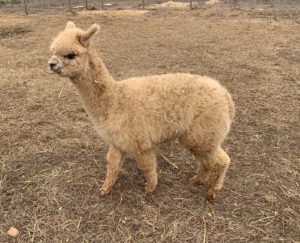
Alpacas are larger than their cousin the vicunas, but smaller than their other cousin the llama. Alpacas have short faces with spear-shaped ears.
There are two types of alpacas and the look of the alpaca will vary based on the type (also called breeds). The huacaya alpaca offers fluffy, thick fiber that is wavy with a crimp. Tighter crimps signify higher-quality fiber. The suri alpaca has longer fiber that is straight and without a crimp.
Alpacas are evaluated and judged on conformation. Desired traits within alpaca conformation include:
- Straight legs in the front and rear
- Straight backs without humps
- Rounder rump (butt)
- Short triangular muzzle
- Spear-shaped ears
- A neck that is 2/3 the length of the back
Desirable esthetic traits include:
- Length of the ear (you do not want long ears that mimic the llama)
- Strong fiber coverage
- Slight Roman nose
- Length of the tail
- Color of the toenails
- Distance between eyes
- Distance between ears
What colors do alpacas come in?

The AOA show system recognizes 16 different colors with 8 additional classes that are not actual colors. Not all alpacas are a singular color and they can have a mix of primary and secondary colors within their fiber.
The 16 recognized colors include:
- White – WH 100
- Beige – BG 201
- Light fawn – LF 202
- Medium fawn – MF 204
- Dark fawn – DF 205
- Lights brown – LB 209
- Medium brown – MB 301
- Dark brown – DB 410
- Bay black – BB 360
- True black – TB 500
- Light silver grey – LSG 401
- Medium silver grey – MSG 402
- Dark silver grey – DSG 404
- Light rose grey – LRG 408
- Medium rose grey – MRG 211
- Dark rose grey – DRG 306
The 8 additional classes include:
- Modern grey
- Classic grey
- Indefinite light
- Indefinite dark
- Pattern
- Pinto
- Fancy
- Appaloosa
White is the most common color and it accounts for over 25% of the registered alpacas within the AOA database.
The highest demand for alpacas is currently those with grey colors. Light rose grey is the rarest and accounts for only 1% of the registered alpacas within the AOA database.
What is the difference between a llama and an alpaca?
Llamas are bigger than alpacas in both height and weight. Llamas have longer faces and larger ears. Llamas were bred as pack animals and alpacas were bred for high quality, luxury fiber.
Llamas are protectors and they are very alert animals. They are pack animals and workers. Alpacas, on the other hand, are timid and more relaxed. Although alpacas are also often alert, they are not used as guard animals like the llama.
We cover 30+ characteristics in our blog post alpacas vs. llamas. We recommend you read that post to get a full list of similarities and differences.
When are alpacas fully grown?
A female alpaca is considered mature at 18 months and a male alpaca is mature at 2-3 years. A fully grown alpaca will measure about 35 inches high at its shoulders.
How long do alpacas live?
Alpacas typically live 15-20 years. The oldest known alpaca is 27 years old. Our oldest alpacas was Grandma Amber who lived to be over 20-years-old.
How much do alpacas weigh?
The birth weight of an alpaca is generally between 8-23 pounds. Adult alpacas typically weigh between 100-200 pounds, with the ideal weight of an adult alpaca being between 105-185 pounds. We have one alpaca named Anastasia who is 240 pounds, but this is not ideal.
How much can alpacas carry?
The answer is very little. An alpaca’s bone structure is not designed for heavy loads. The alpaca’s cousin the llama is a pack animal and used in many countries for transportation of goods.
Can you ride an alpaca?
No, you cannot ride an alpaca. An alpaca’s bone structure is not designed for heavy loads. An alpaca also does not like to have things placed on his back.
Personality Traits
Do alpacas spit?
Alpacas do spit, but they generally do not spit on humans. An alpaca will send a warning spit or a full-blown spit to another alpaca if it is feeling annoyed, threatened, or fighting for food. This is a sign of aggression or dominance.
When I am providing treats to my alpacas, I do not allow them to spit on each other. I give a stern “mom look” and say “no ma’am” to stop the behavior. Alpacas are trainable and this has been a very successful technique for limiting aggression during feeding.
Alpaca breeders will use a “spit test” to assess pregnancy. This is called a spit test. A female alpaca will spit at a male alpaca if pregnant. This spit test is very accurate and commonly used within the industry to assess the status of pregnancy.
How far can alpacas spit?
An alpaca spit can reach a distance of up to ten feet.
Do alpacas bite?
Alpacas are docile creatures and do not to bite humans.
Females will express anger via spitting and use this as their method of communication.
Intact males and herdsires can be aggressive, and a male alpaca fight can lead to injury. Some alpaca breeders will remove a grown male’s fighting teeth to prevent this from happening.
Are alpacas smart?
Alpacas are smart and highly trainable animals. They can learn commands, hand signals, and tricks.
Are llamas or alpacas friendlier?
While the alpaca and llama are cousins, the alpaca is more friendly and much more docile. Thus, the alpaca would be considered friendlier than the llama.
Do alpacas and dogs get along?
Yes and no. Alpacas are known for living peacefully with certain dog breeds like the Great Pyrenees. This dog breed serves as livestock guard dogs and lives within the alpaca barn and pasture. In other cases, alpacas can be fearful of dogs and react with spit or jumping. We own two dogs and we do not allow our dogs to interact with the alpaca herd.
Can alpacas live with other animals?
For the most part, no alpacas do not do well with other animals. They can share a fence line, but you really cannot house alpacas and other livestock in the same barn, fencing, or pasture area. Between parasites and behavioral issues, you'll just have too many problems to keep your alpacas healthy. I've written about this and covered a lot of specific types of animals in my article titled Can I Raise Alpacas With Other Animals.
Can alpacas die of loneliness?
Alpacas are a herd animal, and as such, they require other alpacas for socialization and security. An individual alpaca would be in a constant state of stress and sadness, which compromise its health and could eventually lead to death.
An alpaca herd should have a minimum of three alpacas. This allows for one alpaca to serve as the alpha alpaca and the remaining alpacas to serve as the supporting herd.
Do alpacas make good pets?
Alpacas are docile, social creatures who are smart, trainable, and quirky. These qualities and their overall teddy bear appearance allow them to serve as excellent pets.
It is also important to remember that they are considered livestock and they are a herd animal. Due to this, they require a farming environment and must live with other alpacas to excel.
Alpacas cannot live as singular pets inside apartments, cities, or subdivisions.
You should check on your local zoning rules prior to purchasing any alpacas.
What noises do alpacas make?
Alpacas commonly hum, but they make a number of other noises which include an alarm call, snorting, grunting, screaming, screeching, whistling, and orgling.
These noises are made based on activity with the most common ones including:
- Humming – This is not an aggressive noise. An alpaca mother will use humming to talk to her cria (baby). My alpacas use humming to tell me if they want something or are unhappy with a situation. Like a human child’s cry, you can learn the different humming sounds of your alpacas to know what the hum means.
- Orgling – The male alpaca will make this sound during mating. This sound will attract unbred females, however, it is loud and annoying, so it is not pleasant to humans.
- Screeching – This is associated with aggression and anger. Our alpha alpaca will use this during shearing to express her displeasure with the situation. It ends at the ending of the shearing and she quickly returns to happiness and joy for her newfound appearance.
I talk about alpaca behavior more in my article titled How to Understand Alpaca Behavior and Positively Influence It.
Raising Alpacas
Are alpacas easy to care for?
Alpacas are one of the easiest livestock animals to care for, and quite honestly, they are easier than dogs and cats. They have minimal requirements for food, cleanup, and care. A caveat to that is their health requirements are different than other livestock and you have to care for them in the right way. You need to learn about husbandry best practices so you can raise healthy and happy alpacas. If you don't want to take the time to learn about best practices, I'd recommend you buy a goat.
How many alpacas should you have at one time?
You need to have at least three alpacas to form a herd large enough for the alpacas to feel safe and socialize. Anything less than that will put stress on the animal. My recommendation for new farms is to start with five. This provides enough of a herd for everyone to transition well to their new home.
How many alpacas can live on an acre?
One acre can technically house 2-8 alpacas, although we suggest the minimum herd size be at least three alpacas. We also recommend giving alpacas plenty of space to roam, which will lead to less stress, arguments, and fighting.
Can you keep an alpaca in the backyard?
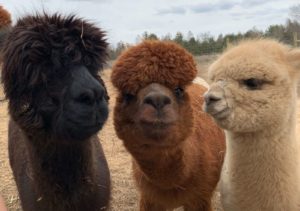
An alpaca could live in a backyard if it had other alpacas and plenty of space. The backyard would need to have an acre dedicated to the alpacas to live, graze, and roam.
The backyard would also require proper shelter and fencing that will protect and deter predators.
If the herd includes both males and females, the males and females cannot live in the same barn or fencing. They must be kept separate to keep the females healthy and safe. Gelded (or castrated) males must also be kept away from females.
How often are alpacas sheared?
Alpacas are sheared once a year. In the Midwest, we shear our herd in the month of May, as this is the optimal time to combat spring’s cold nights and summer’s hot days. Alpaca shearing is generally done by professional teams who travel the country and shear animals at various farms.
Learn more about alpaca shearing in my article titled What to Know About Alpaca Shearing.
Do alpacas stink?
Alpacas do not stink. This is because they are clean animals who prefer to use a communal litter box for peeing and pooping. Alpacas instinctively know to create and use a litter box if one is not provided for them.
How do alpacas sleep?
Most alpacas sleep lying down in a cush (also spelled kush) position at night. Alpacas are also great fans of sprawling out in the sun for afternoon naps.
Where do alpacas sleep?
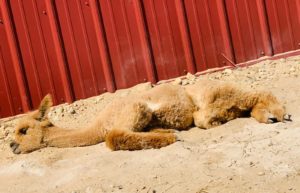
The sleeping location of alpacas will vary by geography, weather, accommodations, and the alpaca's personality itself. Some alpacas will sleep outside all year round and others will always sleep inside a barn.
Our alpacas originally slept outside and even in winter. Now they all tend to sleep in the barn. Our barn offers clean floors, mats, and straw for comfort, which may have shifted their behavior.
How do alpacas mate?
Female alpacas ovulate on sight and do not have a set timeframe or pattern for ovulation. This allows mating to occur at any time, although in the Midwest, we tend to schedule mating in spring to help keep births in the optimal climate for cria health.
The male alpaca will be brought to the female, and if the female is interested, she will lie down and cush. The male will then mount the female from behind and make a very loud and annoying orgling sound. This will last from 10-20 minutes.
A week or so later, a male will be brought back to the female to determine success. If the female spits off, she is considered pregnant. If she does not, a second mating will take place.
How much do alpacas eat?
Alpacas will eat 1-2% of their body weight each day. It costs roughly $220 per year to feed one alpaca.
What do alpacas eat?
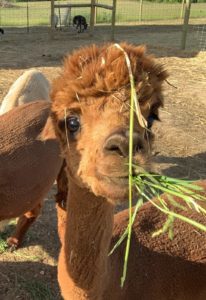
Alpacas require a solid mix of water, energy, protein, minerals, and vitamins. Alpacas also have three stomach compartments, so they are not the same as a common dog or other domestic animals.
Our alpacas have three sources of nutrition:
- Hay
- Pellet supplements
- Minerals
The alpacas have access to quality hay and mineral supplements all day long. We also provide pellet supplements in the morning and evening.
How often do alpacas eat?
Alpacas are grazing animals, so they munch on hay all day long. We also provide our alpacas with pellets in the morning and at night.
Alpacas should always have a solid supply of hay and minerals available.
What are alpacas’ favorite treats?
Many alpacas are fond of lettuce, apples, and regular old fresh weeds as treats. I have lots of alpacas that will eat apples and carrots. They think this is the best snack ever! Others love to munch on raw brussels sprouts. Overall our alpacas prefer their pellet supplements over any human treat.
Expense and Care
How much do alpacas cost?
The most expensive alpaca to sell in the USA went at auction for $650,000. Snowmass Matrix was bought by Double "O" Good Alpacas in February of 2010. This herdsire produced 475 offspring and was a very influential breeder in the American alpaca industry. This price, however, is a record and not the norm.
In today's market, an alpaca can range in price from $0-$100,000. Most pet quality alpacas will be sold around $500-$1,000. Show quality alpacas will range from $3,000-$20,000. A high-quality male can sell for between $40,000-60,000. The price of an alpaca truly varies by country, available supply, as well as the quality of the animal in conformation and fiber. You can learn more about the cost of purchase in my article The Beginner’s Guide to Purchasing a Starter Alpaca Herd or via our list of alpacas for sale.
When evaluating alpacas for fiber usage, a buyer should consider fleece weight, staple length, fiber diameter, crimp, tensile strength, color, and absence of guard hair.
The AOA and alpaca breeder can provide data on the alpaca’s fiber analysis so that the buyer can review actual histogram information to determine the animal’s true quality. This data will include such metrics as fleece weight, mean fiber diameter, standard deviation, spin fineness, comfort factor, and staple length.
If a breeder has registered an alpaca and has a histogram available, you should expect to pay thousands of dollars per animal.
How much does a baby alpaca cost?
A baby alpaca, also called a cria, will cost the same as an adult alpaca. The difference is the baby cannot leave its mother until it is weaned. It will also require companion alpacas to be purchased and housed together as a herd.
Why are alpacas so expensive?
Alpacas are expensive because they were created as luxury animals for the wealthy and aristocrats of South America. They were bred for their luxurious fibers.
Quality alpacas are bred through specific genetic review and breeding programs, are registered with the AOA, and have had histograms run to determine fiber quality. All of this accounts for money that must be recouped in the sale of the animal.
Supply and demand also influence the cost of an alpaca. Grey alpacas, for example, will be more expensive because they are in higher demand and have limited supply.
Are alpacas expensive to keep?
Alpacas are not expensive to keep and tend to be much cheaper than a standard dog to feed. That said, they do require proper shelter, fencing, and food, so there will be startup costs for your herd.
Where do you buy alpacas?
Alpacas should be bought from registered breeders who are members of the Alpaca Owners Association. You can locate alpacas for sale via Google searches, the AOA listings, local association websites, and alpaca shows.
We recommend visiting multiple alpaca farms before making a purchase. You want to make sure your alpaca breeder is well educated on alpacas, the farm is clean, the alpacas have adequate shelter and food, and the alpacas are of the desired quality.
If you are new to alpaca farming, you should also look for an alpaca breeder that will serve as a mentor for you in the first few months of raising alpacas.
I cover much more on alpaca cost and expenses in my article titled Alpaca Cost and Understanding the True Expense of Care.
Revenue Generation
What are alpacas raised for?
Alpacas are primarily raised for their high quality and luxurious fiber. However, they are also raised for animal sales, manure sales, and sometimes sold for meat.
Can you eat alpaca?
You can eat alpaca meat, however, this is not a common dish in the United States. Since alpacas are friendly and smart animals, few farms actually raise them for meat sales.
How much are alpacas worth?
An alpaca is worth what someone will pay for it.
There is no set price, and many times, the purchase can be an emotional one. The higher the quality of fiber and conformation, the more the alpaca is worth.
Alpaca sales are generally between $500-$15,000 per animal.
At the height of the alpaca market sales, one alpaca sold for a record $500,000.
How much money can you make raising alpacas?
An alpaca farm can be a side income, or it can produce enough income to support a family. It really depends on the farm’s business plan, sales and marketing capabilities, and their ability to keep costs at a minimum. I cover this topic in much more detail in my post titled 44 Tips and Resources for Creating a Successful Business Plan and Starting an Alpaca Farm.
Do alpaca farmers make money?
Smart alpaca farmers do make money and they can create enough revenue to make alpaca farming their primary and/or only source of income. The key is to have a solid business plan with a diverse revenue stream.
Alpaca farmers can bring in revenue via the following types of sales and activities:
- Raw fiber sales
- Finished alpaca yarn or roving sales
- Sales of finished alpaca products like socks, scarves, hats, or blankets
- Manure sales
- Animal sales
- Alpaca breeding
- Alpaca boarding
- Alpaca services like themed birthday parties, weddings, or photoshoots
- Bed and breakfast rentals
- Alpaca farm events like alpaca yoga or alpaca farm days
It’s important to have a strong understanding of your target market, their needs, and your ability to serve these needs. If these three elements align, your business plan can be solid, and you can make money as an alpaca farmer.
The Alpaca Handbook: Everything You Need to Raise Healthy and Happy Alpacas
If you've enjoyed this content, you'll love Rebecca's new book. The Alpaca Handbook is the essential guide to raising, breeding, and enjoying alpacas on the farm. The book is a great resource for alpaca owners who raise them for fun or profit. In this 17 chapter, 200+ page, full color book, you’ll learn everything you need to know to become a successful alpaca owner. Each chapter includes educational information, as well as stories that tie this information to real-world experiences.
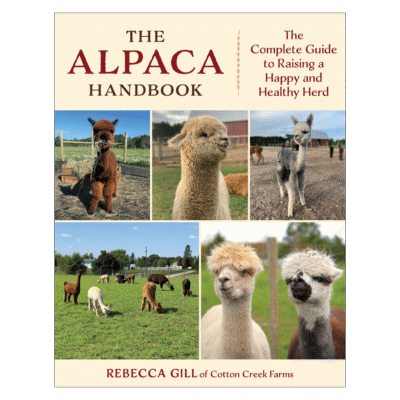




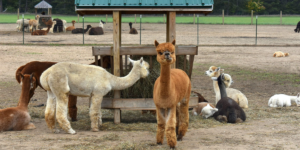
Good article. We raised Suri Alpacas for 10 years. Wonderful animals. Helped raise money for our church youth group selling alpaca poop.
Hi this may not be the place to ask but my 12 month wether rushed up behind me and put front legs on me. I felt he was trying to mount me. He has always been friendly and comes up to me for a scratch making noises. I don’t know what is happening with him but have one other wether to keep him company.
Kerrie while he may be wanting to mate, my guess is he wants to play. This might be especially true since you only have one other alpaca to keep him occupied. I talked about having similar issues with my Levi and Teddy at https://cottoncreekfarms.com/alpaca-behavior/. I was quickly able to stop Teddy and Levi from jumping on me by providing the boys with clear boundaries, so they know I am there to love and care for them, but I am not a playmate and they cannot jump on me.
If you have a female that is pregnant and due approx Sept 13th and you hadn’t seen cria movement would you be concerned and would a spit test help to reconfirm pregnancy.?
Originally spat off at 6mths !
We’ve had lots of pregnant females where we didn’t see much movement. I watch for other signs like crabbiness, round underbelly, and shift in eating habits. When we get closer to the due date I pay close attention to their butts to see if there is any “puffy butt” which is certainly not a technical term. =)
By now you should definitely see a difference in belly size and overall shape, as well as, a shift in personality and general uncomfortableness.
If you suspect a loss pregnancy, I would recommend another spit test and possibly a vet visit.
Thank you for replying!
Definitely keeping an eye on them!
So doing a spit test this close to their supposed due date is ok. ?
Won’t stress them out too much?
Thank you
Penny I would keep the spit test as low key as possible. Walking the male by on a lead would probably be enough to see if she is pregnant. At the end of the pregnancies, the mothers don’t want anyone remotely close to them or their bellies. She should spit off as soon as the male is close.
And if you are at all worried, based on your alpaca’s general personality, I would just hold off until you get closer to the due date and can watch for more signs.
Is there a smell that alpacas hate? I need something to put on my concrete paddocks to keep them from pooping there.
I am not aware of any products you can place on concrete that will discourage the alpacas. We know they don’t like heavy perfumes and locations when we do tours, but that wouldn’t help the situation you are facing. We’ve learned the larger indoor areas you give them, the more they’ll use it for a bathroom facility.
We just started raising 4 alpacas a month ago, and have LOVED every minute. All 4 females, ages 4-12, are delightful but they don’t like to be touched. Is this because their former (2 different) owners didn’t handle them, or because it’s their nature to be stand off-ish? We have put halters on them, spend lots of time with and around them, and hope they become much more comfortable with love and attention! Thank you!
Pam it could be either. Since they are older, it will take longer to warm up.
I do not halter my new alpacas for quite a while. My goal is to build trust with them and then once the trust is fully there, I will halter train if needed.
The best thing you can do is be present. Give them the grace of time. Sit with them, talk to them, bribe them with pellets as treats. Get on their level and just be with them.
Every alpaca is different and they will warm up at different rates. And some, will never fully warm up.
Our Vin likes to be close, but she doesn’t want to be touched. And that’s okay. It’s what makes her comfortable and feeling loved. Attie (who I call Crabby Attie) is one who also liked to be close, but not touched. After a year she still will not eat out of our hands. And yet, this week she gave birth and I can be with her cria and with her close. She is comfortable enough for us to be very close with her and the cria, yet she has no desire to be touched. Again, that’s okay because that is Attie’s personality.
Just like humans, you’ll find introverts and extroverts. The key is to know which one your alpaca is and adapt accordingly.
Thank you so much. Your perspective is very helpful to know!
Hi! My husband and I are also new to raising alpacas. We currently have 2 young, half siblings. One male and one female. We are actively looking for another female to make a herd of 3. When the male must be separated to another pasture should they be alone? Will they get lonely in a pasture alone?
Shelby you need to remove a male at 6 months of age. If you keep the male and females together after that, the male can cause physical harm to the females. They don’t intend to do it, however, it would happen because the male doesn’t have a turn off switch when it comes to breeding.
As a rule, you should have a minimum of 3 alpacas per sex. So either 3 females or 3 males or 3 of each in different sections separated by fencing.
Alpacas are herd animals and they need at least 3 animals to feel physically safe and be mentally healthy. They can literally stress themselves to death when left alone or in small numbers.
Thank you for all the information. I enjoyed learning about these fur babies. Horses has been our interest/showing for many years. I can’t ride anymore due to poor balance. Two brain surgeries, Cancer, Chemo and Radiation. Still love all fur babies. I found your knowledge of Alpacas very interesting. Enjoy them! Blessings!
Ms Gill
Thank you for the forum to ask questions.
I recently purchased a 5-6 year old female alpaca for guarding sheep on summer and winter range.
My question is water requirements for alpacas. When snow is available sheep can eat adequate amounts to meet their daily needs. Can alpacas do the same as sheep? Water is available daily for the sheep but, when snow is available they turn their noses up at water and don’t trail in for water.
James I do not think sheep and alpaca are the same. We have to fill our alpaca waters daily, even with lots of snow on the ground. We’ve experienced no decline in water consumption with snow on the ground. Since you only have one alpaca and she has a new environment, I would encourage you to keep an eye on her for changes in her personality. Alpacas are herd animals and prefer a group of at least three alpacas. Some will fall into a depression or become highly stressed if not in a herd. When that happens their health will also suffer. While this doesn’t happen in every situation, it does happen often.
Hi Rebecca,
Thank you so much for this information. We live on a half acre with a beautiful barn and wanted to add some animals. I was raised on a hobby farm with various types of animals and want my children to experience this as well. do you think it is ok to have alpacas on a small land parcel. They will be so loved and given lots of attention.
Brittney it will depend on if you are feeding them hay or relying on the land for food. How many acres do you have?
I am crocheting with the black alpaca yarn from my daughter’s alpaca. She had sent it to be processed and spun. When we picked it up the woman told us to “wash it” one more time before using it. So I put the skein I got in the sink with very warm water, pressed it down to get as much air out as I could, let it soak for about 20 minutes, moved it around some, squeezed out as much water as I could, and hung out to dry. Now as I’m working with it I am still finding small pieces of grass in it, but there is also some sorry of white dust and slightly larger particles throughout the yarn. It seems the more I work it, the more there is. Looking at it through a magnifying glass it looks slightly translucent almost like a skin cells. Do you have any idea what it would be? I can send a picture of the magnified view and/or the view of the item in crocheting that shows how much there is.
Kris I really don’t know what it could be. It might be something from the alpaca’s fiber or it could be a result of processing at the mill. I would have your daughter check with the mill to see if they had any issues with processing.
I live on a street with acres for each house. Behind my house is a farm. Years ago the farm sold off 66 acres. The other acres houses an alpaca farm. The 66 acres now want to put 99 houses on 33 acres. Would all this noise and housing put a strain on the alpacas. We,all the neighbors around,do not want this building to happen. We want to continue the country life. We are wondering if this is something we can use by the extra population hurting the alpacas. I’d appreciate it if you could let me know.
The alpacas tend to get used to noises around them. Whether it be a dog barking, traffic, or kids playing, the alpacas tend to adapt. While that setting isn’t my idea of country life, I’ve noticed many photos shown in Facebook groups of alpacas living with close-by neighbors.
Got alpaca and they seem to hang out the back will they find the water
Deidre I’m not exactly sure what you are asking. If you are asking if the alpacas will naturally find water on their own, I would not leave that responsibility to them. You should have proper shelter, food, and clean water accessible at all times and where they can easily locate and access it. If your alpacas haven’t warmed up yet, I would recommend sitting with them. And when I say sit, I mean on the actual ground as close to them as they allow. This will allow the alpacas to view you as a non-threat and give them enough confidence to want to get to know you.
I have recently purchased three alpaca at a community auction. I have no information on the animals. Is there a way to find out any information on them? Also, can any alpaca be registered or is there certain criteria? Thank you in advance of your answers. Have a great day!
You can only register alpacas with the Alpaca Owners Association if you have a blood card and know the sire and dam. They will not and cannot register an alpaca without knowing the lineage. I’d recommend seeing if there is a microchip in the alpaca. There might be, and if there is, you could take this information to the association to locate the information.
My wife and daughter would like to start a small alpaca farm we have a couple of acres and in rural Kentucky, looking around I see offerings for animals and marked “deceased” , what are they selling?
Where are you seeing the deceased label? Is it on the AOA’s list or OpenHerd’s list?
Hi, I couldn’t find a place to comment.
My child has a doll with a Alpaca wool “hair.” It has a tendency to quickly become fuzzy or knitted right after it dries or is brushed. Is there a specific way to care for her dolls hair to keep it smoother or silkier? What breed of Alpaca is best for imitation doll hair, Incase I need to replace it. Thank you in advance.
Paula we do not wash or brush live alpacas, which is probably why you are having issues. The fiber mills will wash the raw fiber prior to processing. I would spot clean the stuffed animal only and I would instruct your child to skip the brushing.
Thanks for all this information. This weekend we will be getting 6 females, and 2 males. Our set up would be the females seperate from males, but males will be in a corral within the females lot. The females are likely bred, and I was wondering if the males would be ok together until we have another male OR should I try to purchase another male this weekend so there are three? Hope that made sense. There are other large pastures for them to be lose in, and still females n males will be separate. I want them in the smaller area until they get somewhat use to me and our routine…always putting them up at night. Anyway, so the males will be close to the females but not have access to them, but only 2 males for now….or I should try my best to purchase another male if the seller is willing to part with another? Thanks!!!
Thank you for sharing your knowledge and experience with alpacas. I have a friend with a large size farm in The Dominican Republic. I would like to know if alpacas can adapt to warm climates such as exist in the Caribbean without having a barn. Or should a dedicated barn area with fans and ventilation be built for them. Thank you for your consideration and advice.
You would absolutely need a barn with shade, ventilation, and fans running nonstop. Consider wearing 2 of your warmest and longest coats. Then imagine standing out in the day heat with that on. That is what the alpacas would feel like in your summer weather.
My 15 yo wether has gone off his food, stares off in the distance, now wants to be cuddled when has always been standoffish, not moving around as much, looks sad. Could he possibly be approaching his end of life?
Carol I cannot say if that shift is due to the end of life or a regular illness. I can tell you we would run fecal tests and/or have the vet out to review. The behavior isn’t normal and it does indicate something is possible wrong healthwise.
I want to got baby alpacas, but I am not sure how many to get and am confused, if you get baby alpacas when it is ok for them to leave there mother, do you need to also have an adult alpaca?
Eva we do not sell out babies until they are about a year old and they’d need to go with a buddy.
We require any new farms to purchase at least three alpacas of the same sex, have adequate shelter and fencing, sufficient farm land, and have a hay source lined up prior to contracts being signed. You should expect the same from any quality breeder.
Great article. Is FL too hot for Alpacas? I’m thinking about starting a farm, but don’t want them to be miserable
I have 6 acres of woods. Only 1 acre is fenced in, that I keep goats and two llamas in.
I let the goats free range sometimes on the unfenced area, and they will go back in the fence area when I call them.
I haven’t tried this with my llamas. Do you think they will come in with a bribe of feed like the goats at the end of the day?
Ed I would suspect the answer is very much determined by the llama’s personality. I know we could coax our alpacas in, however, I have no idea what others would do.
If you haven’t already read up on parasite transfer between the goat and llamas, I would encourage you to do so. Sharing space will bring forth additional health risks that you need to proactively manage to protect the llamas.
Hello, me and my family are looking into keeping alpacas. We are considering 3 females. We have half an acre of grazing land, and another half of woodland. My concern in because of the woodland area, we have many poisonous weeds which grow naturally on the land. If we kept the alpacas well fed would they naturally keep away from the weeds? Or would we have to fence them into the grazing land and supplement them with hay feed. I am worried because of our weeds we may not be able able to keep alpacas. Thanks
You have just gained a follower! I’ve never seen such comprehensive and well detailed knowledge about Alpacas. I’ve done research here and there but this is the first time I’ve found your website. I’m thrilled to have found this and will probably start reading all your content. I’m still a ways off from starting a farm but it’s ultimately my goal and dream because I really just love alpacas! Thank you for sharing your expertise!
Thanks so much for stopping by and commenting! I am happy to hear the blog has been helpful. I have more content in the works!